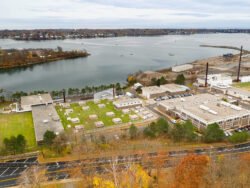Passaic Valley Sewerage Commission
The Passaic Valley Sewerage Commission (PVSC) is one of the largest wastewater treatment plants in the United States, serving over 1.5 million residents in the Passaic Valley region of New Jersey. With a history dating back over a century, the PVSC plays a crucial role in ensuring clean waterways and protecting public health in the surrounding communities.
Background and History
The PVSC was established in 1902 to address the growing pollution and public health concerns caused by inadequate sewage treatment in the Passaic Valley region. At the time, the Passaic River was heavily polluted with raw sewage, industrial waste, and other contaminants, leading to widespread waterborne illnesses and environmental degradation.
To combat these issues, the PVSC was tasked with constructing and operating wastewater treatment facilities to treat sewage before it was discharged into the river. Over the years, the PVSC has expanded its operations, infrastructure, and capacity to keep pace with the region’s growing population and the increasing demands for wastewater treatment.
Today, the PVSC operates one of the largest wastewater treatment plants in the country, capable of treating up to 330 million gallons of wastewater per day. The plant uses advanced technology and processes to remove pollutants, pathogens, and other harmful substances from the wastewater before it is discharged into the Passaic River.
Environmental Impact and Public Health
The PVSC plays a critical role in protecting the environment and public health in the Passaic Valley region. By treating wastewater before it is released into the river, the PVSC helps prevent water pollution, reduce the spread of waterborne diseases, and safeguard the natural ecosystems and wildlife that depend on clean waterways.
In addition to its wastewater treatment operations, the PVSC is actively involved in environmental monitoring, research, and compliance to ensure that its activities are in line with state and federal regulations. The PVSC works closely with regulatory agencies, environmental organizations, and local communities to promote sustainable practices, mitigate environmental impacts, and address emerging threats to water quality and public health.
One of the key challenges facing the PVSC is the presence of legacy contaminants in the Passaic River, including heavy metals, PCBs, and other toxic substances. These pollutants were discharged into the river decades ago by industrial facilities and other sources, leading to long-term environmental and public health concerns. The PVSC is working on remediation efforts to clean up the river and minimize the impact of these contaminants on the local communities.
Community Engagement and Education
The PVSC is committed to engaging with the communities it serves and promoting environmental education and awareness. The PVSC regularly hosts public tours, workshops, and events to educate residents about wastewater treatment, water conservation, and pollution prevention. By raising awareness and fostering community involvement, the PVSC seeks to build partnerships, promote sustainable practices, and empower residents to take action to protect water resources and public health.
Moreover, the PVSC collaborates with local schools, universities, and environmental organizations to develop educational programs and initiatives that promote environmental stewardship and inspire the next generation of environmental leaders. By investing in education and outreach, the PVSC aims to cultivate a culture of environmental responsibility and empower individuals to make informed choices that contribute to a healthier, more sustainable future.
Challenges and Opportunities
Despite its significant accomplishments and contributions to the region, the PVSC faces several challenges and opportunities as it continues to fulfill its mission. One of the key challenges is the need to upgrade and modernize its infrastructure to meet the evolving demands for wastewater treatment, comply with stricter regulations, and adapt to emerging environmental threats, such as climate change and emerging contaminants.
Another challenge is the need to secure adequate funding and resources to support its operations and capital improvement projects. The PVSC relies on a combination of user fees, grants, and loans to finance its activities, and the cost of maintaining and upgrading its aging infrastructure continues to rise. Securing sustainable funding sources and pursuing cost-effective solutions are essential to ensure the long-term viability and effectiveness of the PVSC’s operations.
Despite these challenges, the PVSC also has opportunities to enhance its sustainability, resilience, and overall performance. By investing in green infrastructure, renewable energy, and innovative technologies, the PVSC can reduce its environmental footprint, improve energy efficiency, and enhance its ability to withstand and recover from natural disasters and other emergencies.
Furthermore, the PVSC can strengthen its partnerships with other stakeholders, such as local governments, businesses, and environmental organizations, to leverage resources, share best practices, and collaborate on common goals, such as water quality improvement, pollution prevention, and community engagement.
Conclusion
The Passaic Valley Sewerage Commission plays a vital role in safeguarding water quality, protecting public health, and promoting environmental sustainability in the Passaic Valley region. With a long history of service, a commitment to excellence, and a vision for the future, the PVSC is well-positioned to address the challenges and opportunities facing the wastewater treatment industry and make a positive impact on the communities it serves.
By continuing to invest in innovation, education, and community engagement, the PVSC can build on its legacy of success, enhance its resilience and effectiveness, and inspire others to join in the effort to ensure clean waterways, healthy communities, and a sustainable future for generations to come.
Sources:
1. Passaic Valley Sewerage Commission, “About PVSC,” https://www.nj.gov/pvsc/
2. New Jersey Department of Environmental Protection, “Passaic Valley Sewerage Commission,” https://www.nj.gov/dep/pvsc/
3. Environmental Protection Agency, “Water Pollution Control,” https://www.epa.gov/water-pollution-control.


